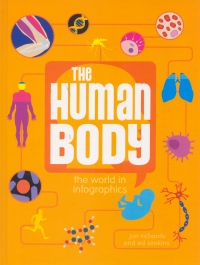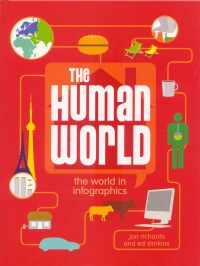| ________________
CM . . .
. Volume XX Number 14. . . .December 6, 2013
excerpt:
The latest books in “The World in Infographics” series, The Human Body” and The Human World, live up to the high standards set by the first two books in the series, The Natural World and Planet Earth. Wikipedia defines infographics as “graphic visual representations of information, data or knowledge intended to present complex information quickly and clearly.” In The Human Body and The Human World, authors Jon Richards and Ed Simkins successfully use colourful graphics, icons and pictograms, combined with concise text, to present complex information about the human body and the human world in a format with is easy for young readers to understand quickly and clearly. Consistent with the two earlier books in the series, each of these books begins with a colourful table of contents which combines topics and page numbers in circles with some related illustrations. The books also include an excellent glossary. The index is presented in alphabetical order, but the font size varies as in a tag cloud to represent which words are found most frequently on the pages indicated. Also included is a list of resources for more information divided between two topics. “More Graphics” lists websites on a wide range of topics presented graphically, such as “dailyinfographic.com”. “More Info” lists resources on the main topic of the books. For example, The Human Body includes a citation for www.kidshealth.org, and “The Human World includes a citation for www.cyberschoolbus.un.org/. Although there are no citations for the facts presented in the books, several sources of information are credited at the bottom of the glossary pages. Teaching guides for the first two books in the series are available for download from the publisher’s website www.owlkidsbooks.com. Teaching guides for the two new books are scheduled to be available soon. The Human Body covers topics ranging from specific organs and systems, the senses, reproduction, maturation, and a section on “Spare Parts” that identifies different parts of the body that can be repaired or replaced with natural or artificial parts. The Human World covers topics such as population growth, population density around the world, wealth distribution, water access and use, transportation, communication, and waste. Examples come from locations around the world. For example, “The city of Guiyu in China is the center of a huge electronics recycling industry. Each year, 5,500 companies in the city employ about 150,000 people to dismantle computers, cell phones, and other electronic devices.” Once again, well done Owlkids Books. Whether teachers are using these books to teach how to interpret and visualize facts and statistics from graphs, pictograms, and illustrations, or whether students are engaging with the information on their own, the books are sure to be popular learning tools. More proof that learning complex concepts doesn’t have to be tedious or boring if the information is presented in the right format. Highly Recommended. Suzanne Pierson, a retired teacher-librarian, is currently instructing Librarianship courses at Queen’s University in Kingston, ON.
To comment
on this title or this review, send mail to cm@umanitoba.ca.
Copyright © the Manitoba Library Association. Reproduction for personal
use is permitted only if this copyright notice is maintained. Any
other reproduction is prohibited without permission.
NEXT REVIEW |
TABLE OF CONTENTS FOR THIS ISSUE
- December 6, 2013.
AUTHORS |
TITLES |
MEDIA REVIEWS |
PROFILES |
BACK ISSUES |
SEARCH |
CMARCHIVE |
HOME |

